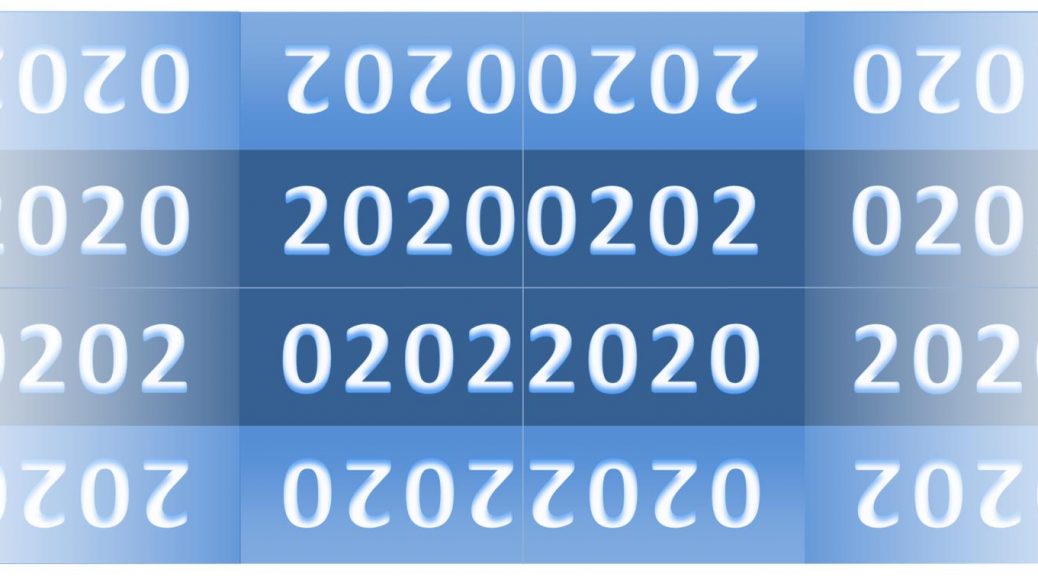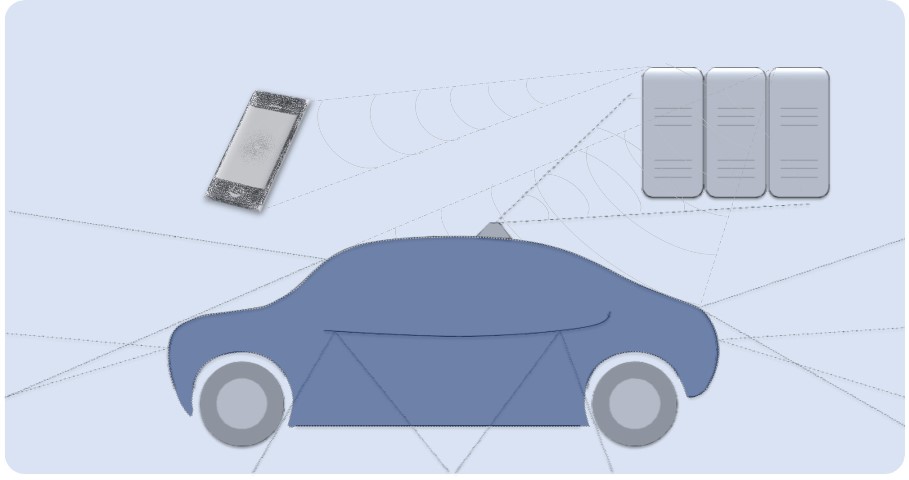The year 2020 is definitely a very special one for all those who have a sense of symmetry – and this disposition was given to us by the evolution. Depending on the date format used, there are several palindrome days this year, i.e. dates that are symmetrical (or palindromic).
When written in the international ISO 8601 format YYYYMMDD, 2020-02-02 is the first palindromic date since 2011-11-02. In between there are 3014 days (more than 8 years). Of course, this is also a symmetrical date when written in the American format MMDDYYYY, i.e. 02/02/2020.
Moreover, that date is also palindromic in the long German date format DDMMYYYY, this is 02.02.2020. This format is also used in many other countries. It is the first such date since 21.02.2012 (2903 days ago). Please note: the symmetry is evaluated by neglecting the delimiter symbol.
What’s next?
In February there are two additional palindromic dates in the short American format MMDDYY. These are 02/11/20 and 02/22/20. Depending on the used format we will experience further palindromic dates in the next year. In ISO YYYYMMDD format this will be 2021-12-02 which is also palindromic in the American format (12/02/2021). In the German DDMMYYYY format there will be two such dates in the near future, one in 2021: 12.02.2021, and another one in 2022: 22.02.2022 (which is not palindromic in the ISO format).
People who use the short German date format DDMMYY will encounter another symmetry this year on 02.11.20 (2020-11-02 = November 2nd, 2020). The previous symmetrical date in this format was 21.11.12 (2012-11-21) which is almost 8 years ago (2903 days). The closest future symmetrical dates in this format will be 12.11.21 and 22.11.22. A little bit later on 12/11/21 and 12/22/21 we see further symmetrical dates in the short American format MMDDYY.
Is it going on like this?
Why, no. After this accumulation of palindromic dates, we will experience a long lasting „dry spell“ which will only end on 2030-03-02 (ISO format), 03/02/2030 (American format), 03/11/30 (short American format), 03.02.2030 (long German format), and 03.11.30 (short German format), respectively. See the tables below.
By the way
The very first palindromic date in ISO YYYYMMDD format after 1000-01-01 (Jan 01 1000) was 1001-10-01 (Oct 01 1001).
2020-02-02 is the 47th palindromic date in the YYYYMMDD format after the reference date 1000-01-01. In total, 372579 days have passed since then. The 331st and very last such date before the year 10000 is 9290-09-29 (Sep 29 9290). This will be the 3028132nd day after 1000-01-01 and therefore is still 2655553 days away (after 2020-02-02).
It is a little bit different in the DDMMYYYY format. The following applies here: 02.02.2020 is the 67th palindromic date after the reference date 01.01.1000. The last possible symmetrical date before the year numbers become five digits long is 29.09.9092 which is the 335th such date in the list. It’s just the 2955814th day after 01.01.1000.
Hint: Because of the Gregorian Calendar Reform of 1582, the numbers of days after 1001-01-01 are fictitious, strictly spoken. They are valid only then, if we adopt the reform for dates before 1582, subsequently. To get the real number of days after ‘Jan 1, 1000’ for years after 1582 subtract 5 from each term representing a date after 1582. This applies to all palindromic dates after the 43rd in YYYYMMDD format, and after the 61st in DDMMYYYY format. The value 5 comes from the 10 skipped “Gregorian” dates between 1582-10-04 (Oct 4, 1582) and 1582-10-15 (Oct 15, 1582) minus the 5 additional Julian leap days in the years 1000, 1100, 1300, 1400 and 1500 which are not Gregorian leap years.
Useless knowledge?
Do not ask about the benefits of these considerations and let me quote Bertolt Brecht: „Thinking is one of the greatest pleasures of the human race“. Jean-Baptiste le Rond d’Alembert (you should know him; possibly you remember the convergence criterion for infinite series that was named after him) says it even more clearly: „Mathematics is a kind of toy that nature has thrown at us for comfort and entertainment in the darkness“. – In Praise of Idleness.
Tables
Altogether, there are 331 palindromic dates in the YYYYMMDD format and 335 such dates in the DDMMYYYY format (between the years 1000 and 9999). The following two tables show excerpts from the complete lists of dates for both formats. In both cases the symmetry is evaluated neglecting the delimiter symbol.
Excerpt of palindromic dates in the YYYYMMDD format.
| # | Date | # of days after 1000-01-01 |
| 1 | 10011001 | 638 |
| 2 | 10100101 | 3652 |
| 3 | 10111101 | 4321 |
| 4 | 10200201 | 7335 |
| … | … | … |
| 44 | 20011002 | 365882 |
| 45 | 20100102 | 368896 |
| 46 | 20111102 | 369565 |
| 47 | 20200202 | 372579 |
| 48 | 20211202 | 373248 |
| 49 | 20300302 | 376260 |
| 50 | 20400402 | 379944 |
| 51 | 20500502 | 383626 |
| 52 | 20600602 | 387310 |
| … | … | … |
| 326 | 92400429 | 3009717 |
| 327 | 92500529 | 3013399 |
| 328 | 92600629 | 3017083 |
| 329 | 92700729 | 3020765 |
| 330 | 92800829 | 3024449 |
| 331 | 92900929 | 3028132 |
Excerpt of palindromic dates in the DDMMYYYY format.
| # | Date | # of days after 01.01.1000 |
| 1 | 10011001 | 374 |
| 2 | 20011002 | 749 |
| 3 | 30011003 | 1124 |
| 4 | 01011010 | 3652 |
| … | … | … |
| 65 | 11022011 | 369301 |
| 66 | 21022012 | 369676 |
| 67 | 02022020 | 372579 |
| 68 | 12022021 | 372955 |
| 69 | 22022022 | 373330 |
| 70 | 03022030 | 376233 |
| 71 | 13022031 | 376608 |
| 72 | 23022032 | 376983 |
| 73 | 04022040 | 379886 |
| … | … | … |
| 330 | 08099080 | 2951410 |
| 331 | 18099081 | 2951785 |
| 332 | 28099082 | 2952160 |
| 333 | 09099090 | 2955063 |
| 334 | 19099091 | 2955438 |
| 335 | 29099092 | 2955814 |
Finally, here are the complete lists of symmetrical dates in the DDMMYY and in the MMDDYY format: The symmetry is valid with and without the delimiter symbol.
All palindromic dates in the DDMMYY format.
| # | Date | # of days after 01.01.00 |
| 1 | 101101 | 619 |
| 2 | 201102 | 994 |
| 3 | 301103 | 1369 |
| 4 | 011110 | 3897 |
| 5 | 111111 | 4272 |
| 6 | 211112 | 4648 |
| 7 | 021120 | 7551 |
| 8 | 121121 | 7926 |
| 9 | 221122 | 8301 |
| 10 | 031130 | 11204 |
| 11 | 131131 | 11579 |
| 12 | 231132 | 11955 |
| 13 | 041140 | 14858 |
| 14 | 141141 | 15233 |
| 15 | 241142 | 15608 |
| 16 | 051150 | 18511 |
| 17 | 151151 | 18886 |
| 18 | 251152 | 19262 |
| 19 | 061160 | 22165 |
| 20 | 161161 | 22540 |
| 21 | 261162 | 22915 |
| 22 | 071170 | 25818 |
| 23 | 171171 | 26193 |
| 24 | 271172 | 26569 |
| 25 | 081180 | 29472 |
| 26 | 181181 | 29847 |
| 27 | 281182 | 30222 |
| 28 | 091190 | 33125 |
| 29 | 191191 | 33500 |
| 30 | 291192 | 33876 |
All palindromic dates in the MMDDYY format.
| # | Date | # of days after 01/01/00 |
| 1 | 101101 | 589 |
| 2 | 102201 | 600 |
| 3 | 011110 | 3603 |
| 4 | 012210 | 3614 |
| 5 | 111111 | 4272 |
| 6 | 112211 | 4283 |
| 7 | 021120 | 7255 |
| 8 | 022220 | 7297 |
| 9 | 121121 | 7955 |
| 10 | 122221 | 7966 |
| 11 | 031130 | 10967 |
| 12 | 032230 | 10978 |
| 13 | 041140 | 14651 |
| 14 | 042240 | 14662 |
| 15 | 051150 | 18333 |
| 16 | 052250 | 18344 |
| 17 | 061160 | 22017 |
| 18 | 062260 | 22028 |
| 19 | 071170 | 25699 |
| 20 | 072270 | 25710 |
| 21 | 081180 | 29383 |
| 22 | 082280 | 29394 |
| 23 | 091190 | 33066 |
| 24 | 092290 | 33077 |

